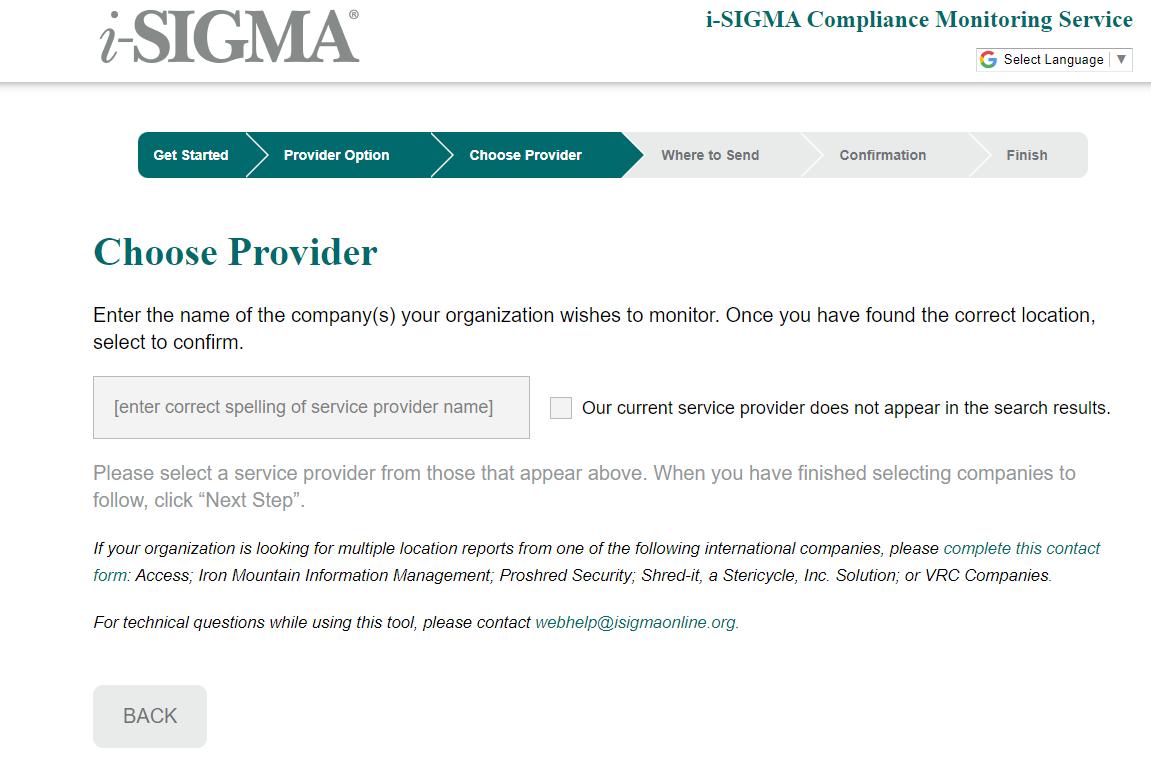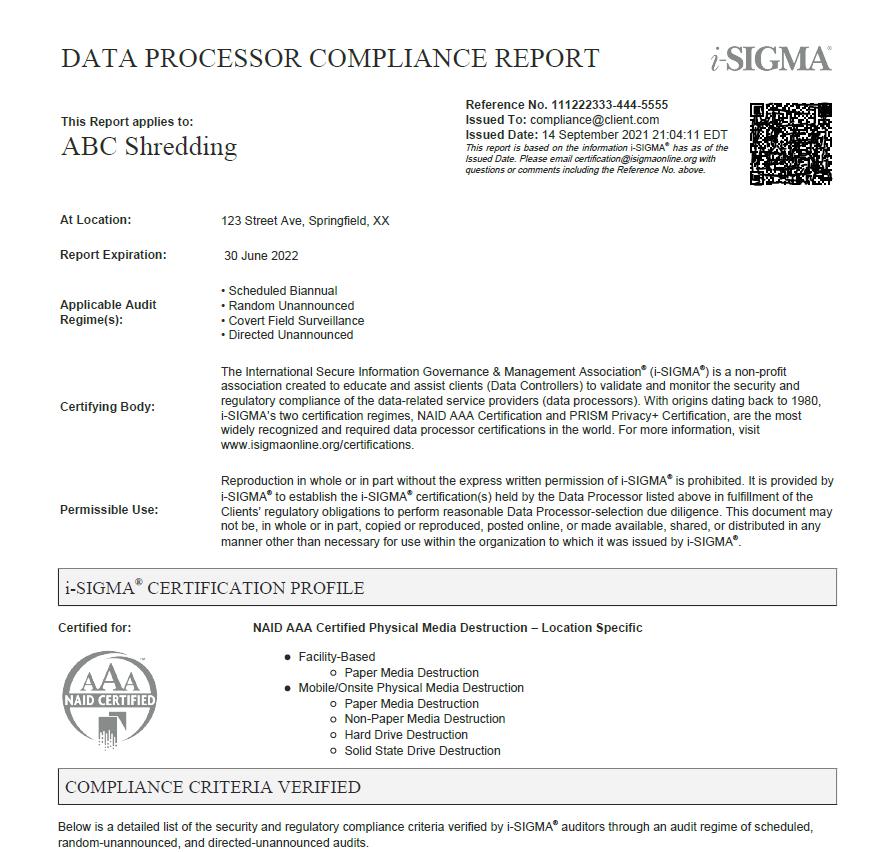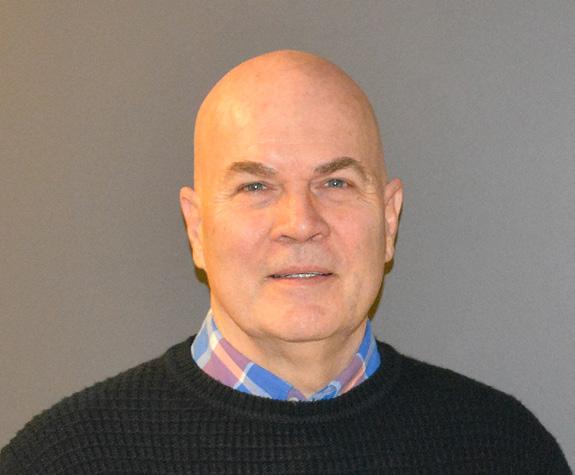
10 minute read
Embracing Certification’s New Relevance
by i-SIGMA
i-SIGMA CEO Bob Johnson explains how the coming changes will further emphasize and clarify the value of the association’s industry-leading certifications.
Over the decades, the service provider certifications offered by i-SIGMA have become integral to the fabric of the secure data destruction and records management industries. And, while their specifications have evolved to keep up with changing regulatory changes, so has their relevance.
From their origins as market distinguishers and client reassurance, these programs have emerged to become tools by which clients are able to meet their data processor selection regulatory requirements, while at the same time helping service providers identify and implement the policies, procedures, and security necessary to operate within a global regulatory framework.
More than anything else, this accomplishment has required a constant vigilance by the association to monitor and respond to the ever-changing data protection regulations around the world and a willingness by service providers and the board of directors to evolve the programs to meet those demands.
Nowhere is this attentiveness and adaptability more apparent than the five changes listed below, all of which will be effective the first of January 2022, and all of which herald a bright future for the service providers willing to embrace them.
#1 - THE GREAT “CLARIFCATION” & THE RESULTING OPPORTUNITY
As most readers already know, starting in thethe New Year, NAID membership and PRISM International membership—and their respective membership logos—will be a thing of the past. They are being replaced by i-SIGMA membership and its logo.
To put a finer point on this, as of 1 January 2022, references to NAID and PRISM International membership will be deemed inappropriate and misleading, since, legally, the members of the organization voted to do away with them earlier this year.
If this is new information or one might be questioning why members made this decision, it was to overcome ongoing market confusion between membership and certification. Once fully implemented, all members will be i-SIGMA members, while “NAID” will strictly be associated with NAID AAA Certification, and references to “PRISM” will be limited to PRISM Privacy+ Certification.
With this new clarification comes the choice and opportunity to transition from being a NAID or PRISM member to becoming certified. Clients who have already come to know NAID and PRISM as representing service provider qualifications will continue to do so. Whether those clients had been aware of the difference between membership and certification in the past, it won’t matter in the future. With regard to NAID and PRISM, certification is all they can mean.
Will some service providers decide not to renew if they can no longer use the NAID or PRISM membership logo? Probably. But, on the other hand, now knowing that customers can no longer be confused, other high-quality service providers, for whom the preexisting confusion was a negative, will make the transition.
#2 – COMPLIANCE MONITORING: THE TRUE VALUE OF CERTIFICATION
Much has been written about the i-SIGMA Compliance Monitoring Service. In the coming months, many service providers will use it and soon clients around the world will begin seeing promotions encouraging them to use it too. And, if the underlying assumptions behind its creation are correct, they will eventually come to rely on it as a vital demonstration of their own regulatory compliance.
All data protection regulations require clients to demonstrate initial and ongoing due diligence when selecting third-party service providers to process personal information. The key word there is “demonstrate.” In fact, when a large investment firm was recently fined after its discarded electronics exposed personal information about its clients, the judgment was based on the fact that they failed to employ “adequate due diligence in selecting a vendor and monitoring its performance.” Of course, the challenge to clients (such as the investment firm) of complying with such regulations is that, 1) they rarely have the bandwidth to perform such due diligence and, 2) even if they did have the bandwidth, they can hardly be expected to know what to look at. Enter i-SIGMA certification program, which are not only designed to review the relevant regulatory and security overlap, but to do so on an ongoing basis.

By obtaining the automatic reports issued by the i-SIGMA Compliance Monitoring Service, the client has evidence by which they can demonstrate both initial and ongoing compliance of their service provider. In short, the client themselves gets the tangible benefit of being able to demonstrate their own vendor-selection compliance requirements.
Clearly, any client will see the value of obtaining this free report, and once they are aware it is available will come to insist on it.

In the event of a breach, the first thing a regulator is likely to ask is “Who is the employee responsible over this?”
#3 – REQUIRING THE ASSIGNMENT OF A DATA PROTECTION OFFICER
The regulatory requirement to designate an individual as being accountable for regulatory compliance is not a new concept. The EU Data Protection Directive had it back in 1995. And, though less specific in the requirement, HIPAA and GLBA in the US and PIPEDA and the PIPAs in Canada, include the principle of management accountability for data protection regulatory compliance.
Of course, it stands to reason. How could any organization reasonably expect to be compliant if there is no one specifically responsible? In the event of a breach, the first thing a regulator is likely to ask is “Who is the employee responsible over this?” I am sure any reader can imagine how negligent it would appear to answer, “No one,” or “We don’t know.” That being said, the assignment of a Data Protection Officer (DPO) should not be taken lightly. In order for it to withstand regulatory scrutiny, the individual selected should have a capacity to both understand what is required, and the authority and lines of communication to assure compliance.
Luckily, i-SIGMA certifications do most of the work for them, insofar as they have identified and addressed the relevant compliance overlap, and will continue to monitor and implement changes in that regard. Stated another way, should a firm hold one of i-SIGMA certifications, the DPO of that firm can be reasonably sure they are doing all that is necessary to be compliant from the perspective of a data processor.
In the coming weeks, i-SIGMA will be holding free webinars on the role of the DPO and options for compliance. It should be noted that in Europe, where the DPO is a more formally defined entity with important statutory obligations, many service providers, including many i-SIGMA members, are outsourcing this function. Whether this will happen elsewhere in the world is yet to be seen. The purpose of the webinars is to make sure members know the issues, know their options, and make prudent decisions.
#4 – REQUIRING THE ASSIGNMENT OF A CERTIFICATION COMPLIANCE OFFICER
Closely related to the new DPO requirement, also starting the first of January 2022, i-SIGMA certifications will require service providers to designate an i-SIGMA Certification Compliance Officer (ICCO). While it is envisioned that some service providers will name the same individual to be both DPO and ICCO, that cannot be assumed. While the DPO may be outsourced depending on the preference of the service provider, the ICCO must be an employee of the certified service provider with the authority and accountability to reasonably ensure certification compliance across the enterprise.
#5 – ADDING AN IMAGING/DIGITIZATION ENDORSEMENT
While NAID AAA Certification includes a number of “endorsements” that apply to various methods of media destruction, up until now, PRISM Privacy+ Certification has been limited to Records Storage. That is no longer the case.
The i-SIGMA Board of Directors recently approved an Imaging/Digitization Endorsement for PRISM Privacy+ Certification, which will allow members providing scanning, imaging, and digitization services to demonstrate their compliance with industry-accepted best practices. As with all i-SIGMA Endorsements, there is no additional fee
What to Watch for in Illegitimate Certifications
Here are a few items clients should keep an eye out for in vetting legitimate certifications vs. those that are not up to par. Note, this list was originally published in Issue 2 of the 2019 iG Journal; read the article to access the full list.
Falsely Claiming to Meet Certification Standards
This happens when a service provider represents they meet the NAID AAA or PRISM Privacy+ Certification standards but fails to complete the required audits. They do not claim to be certified but instead claim to “meet” the requirements.
THE PROBLEM:
The claim to “meet” NAID AAA Certification or PRISM Privacy+ Certification standards is a “false” claim; the third-party audits, scheduled and unannounced, built into the program are as critical as any other specification. A service provider cannot “meet” the standard if they are not subject to the audits. Self-declaration defeats the integrity of submitting oneself to the scrutiny of unannounced audits, which is an essential component of the program’s ability to ensure a customer is fulfilling their due diligence obligation reference earlier.
THE REMEDY:
Same as #1 above… Clients should verify a company’s NAID AAA Certification or PRISM Privacy+ Certification on the association’s Service Provider Locator, directory.
Promoting Use of “Certified” Software or Equipment as a Qualification
Computer recyclers sometimes advertise their use of “certified” software overwriting solutions. Additionally, service providers that provide physical destruction or degaussing of media, sometimes advertise their use of “certified” or “approved” equipment.
THE PROBLEM:
The fact that a service provider uses “certified” software or equipment says nothing about their employee screening or training, regulatory compliance, access controls, or breach notification preparedness. Despite many requests, NAID and PRISM ’International have
for members adding this endorsement, and compliance is based on meeting a limited number of applicable requirements in addition to those already required for PRISM Privacy+.
As digitization increases in popularity over the coming years, and as regulatory pressure on clients continues to favor service provider certification, the new endorsement is also expected to attract new members seeking the assurance of the program and the advantages of the new Compliance Monitoring Service (#2 above).
PURPOSE AND POISE
i-SIGMA certifications have –by necessity– always been dynamic and responsive. And, while this puts demands on both leadership and service providers, these are the very factors that have been the key to their continued adoption. Data protection regulations do not change on a schedule, and data protection certifications do not have the luxury of only being updated every five years.
In the regulatory environment that is now emerging, clients will not have the time, knowledge, or inclination to verify on an initial and ongoing basis that service providers responsible for their compliance are doing the right things. It is clear that they will continue to turn to legitimate, relevant certifications.
refused to certify the efficacy of software and equipment specifically because customers could be misled that its use implies the services using them meet overall operational requirements.
THE REMEDY:
Clients should not rely on the use of certified software or equipment as a measure of a service provider’s operating qualifications and, furthermore, clients should be suspect of any service provider proposing their use of certified software or equipment as the sole measure of their security and regulatory compliance.
Claiming an Inferior Certification
Regulatory requirements for clients to validate service provider qualifications have led to the creation of questionable and inadequate certifications.
THE PROBLEM:
Service providers hoping to prey on clients’ unfamiliarity with legitimate certifications, obtain inferior, selfcertification, requiring no audits and no transparent specifications. Often, these certifications are created and sponsored by a for-profit organization with little transparency or accountability.
THE REMEDY:
When presented with a questionable certification as a vendor qualification, clients should verify the certification body itself is legitimate, and that it’s corporate structure is that of a non-profit required to maintain the appropriate level of transparency.
Claiming to Meet an Un-Auditable Standard
There are some legitimate standards that do NOT require an audit regime. Because no audit is required, there is nothing inherently wrong with a service provider claiming to meet them. NIST 800-88 is an example; any firm may claim to meet the standard with no third-party verification.
THE PROBLEM:
The unaudited claim to meet the NIST 800-88 for media sanitization or the D.o.D. standard for hard drive wiping (no obsolete) is intended to infer some assurance to the client, when it is really no more than a claim. It may or may not be true, and there is no assurance in and of itself.
THE REMEDY:
Where a service provider suggests they “meet” a standard, it is important to know who is auditing it and how it is audited (frequency, random, auditor qualifications, etc.) to understand the validity behind the claim.
Bob Johnson is the CEO of i-SIGMA. He can be reached at rjohnson@isigmaonline.org.







